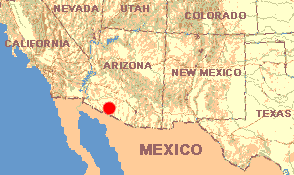 March 10, 1988
March 10, 1988ARIZONA: Pima County
In desert off AZ Hwy. 85 about ten miles SE of Ajo, just north of the entrance to Organ Pipe Cactus National Monument
 March 10, 1988
March 10, 1988If this morning at 7 o'clock you had begun walking with me through the Creosote-bush dominated desert, down several dry, shallow, sandy creek-beds, while the temperature rose from 42° to 50°, and the sky remained calm and clear, these are the birds you'd have seen:
The bird most fun watching was the Gambel's Quail. Also it was the most handsome. With a black teardrop-topknot debonairly pendant over the front of its head, a black face- mask set off by neat, white lines, and a rich, chestnut-colored crown similarly delineated with a white border, the male bird is extremely pretty. The duller female is better suited for sitting camouflaged on her nest. Here this species seems to relish being close to people. Near the highway where several families of Northerners have parked their trailers at an informal roadside pull-off, each morning a covey of about ten quail run about on the sand beneath the Creosote-bushes. Farther into the desert, where I'm parked, no quails are to be seen. At dawn they make remarkable sounds -- squeaks and twangs suggestive of tiny moon-men. Occasionally an individual mounts into a Creosote-bush's upper branches and calls with a sound somewhat like a cat's meow.
Ravens also are fun to see. This morning one perched croaking in the very top of an arroyo-side tree called Tetosa, Olneya tesota. When another Raven of the same size landed beside it, the newcomer immediately spread its fluttering wings and leaned toward the first, opening wide its beak. It was a fledgling begging food from its parent. A sizable hunk of red flesh forthwith appeared in the adult's beak. Since the fledgling had been blocking my view, I'm not sure whether the parent had held the flesh in its claws, or whether the flesh had been disgorged. After the feeding, both birds perched nonchalantly for a minute or so, then the first Raven flew off down the arroyo. The newcomer remained, simply gawking around, wiping its beak on the tree's branch, and making a remarkable sound -- like bongo drums, maybe, except without the wooden quality -- bu-bu-bu-bu-bah!
Phainopeplas are red-eyed members of the same family as waxwings. The crested male looks like a black, tanager-sized cardinal while the female is brownish. Very common here, they fly gracefully and call softly, and are altogether nice little birds.
The Ash-throated Flycatcher observed was perched about two feet high in a large Creosote-bush. As I watched, suddenly it streaked to the sandy ground, captured something, and returned to the bush with a slender tail disappearing down its gullet. Since I've seen small lizards in this area, I'm assuming that this flycatcher ate a lizard. I've never seen any flycatcher eat anything but insects and insect-like critters, but then I haven't been around many ash-throated ones.